Email marketing is one of the most effective tools for online business. Constant Contact reports that this form of marketing has a return on investment (ROI) of $36 for every $1 spent.
That’s why it’s vital to understand email marketing.
This guide breaks it down and shows you exactly how email marketing works.
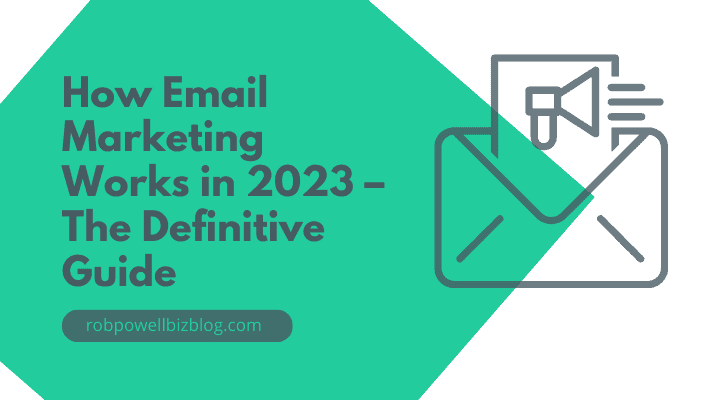
Why You Need an Email List
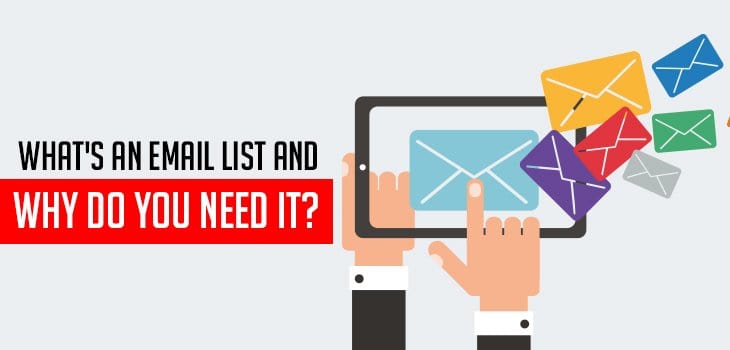
(Source)
There are many good reasons why you should start an email list.
But the most important one is this:
Unless you have a way of staying in touch with your visitors, you’ll never be able to bring your visitors back to your website. And if you’re doing any kind of business, that’s a disaster.
Why?
Because the average customer needs to see your message 7 times before they make a purchase.
That’s an old marketing adage. There’s nothing magical about the figure 7 – it’s just a way of saying that a customer rarely makes a purchase the first time they see your message.
But here are some more reasons you should start building an email list.
Email marketing conversion rate
SearchEngineWatch reports that email has higher conversion rates per session than search and social combined (Email 4.16%, Search 2.64%, Social 0.48%)
Everyone uses email
Even though it’s old school technology, email is used more widely, more frequently and more regularly than any other channel. According to Forbes, people in the USA check their email – on average – 15 times per day.
And the Content Marketing Institute reports that 87% of marketers use email campaigns to nurture their audiences.
Return on investment (ROI)
The ROI of email marketing is higher than either search or social.
The Smart Data Collective cites a 2011 study which found that every dollar spent on email marketing generated a $40.56 return. The next closest channel was search engine marketing, with a return of $22.44 for every dollar spent.
You own your own list
Your social media account doesn’t belong to you – it could get suspended at any time, for any reason.
Google Search is a fantastic source of free traffic but with an algorithm change your traffic could evaporate literally overnight.
In either scenario, your business would grind to a halt.
But if you have a large, engaged list of subscribers, both those things could happen and your business would just carry on, unaffected.
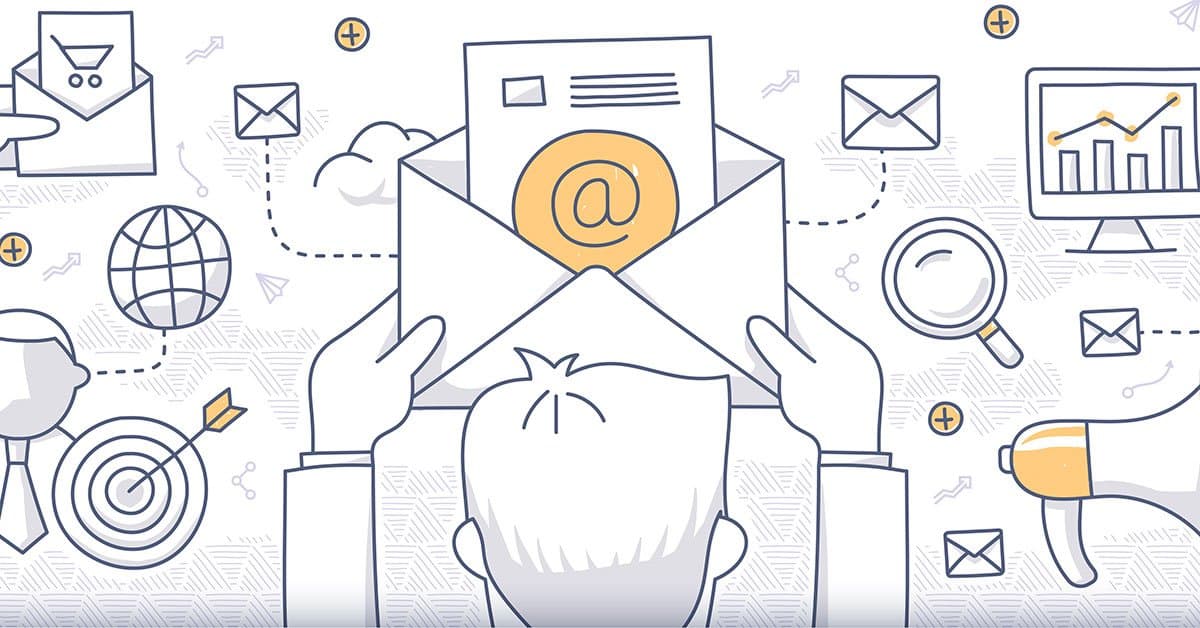
(Source)
Building Your Email List
So, how do you build a list?
This is key to understanding how email marketing works.
The best way to build your list is to place an optin form at strategic places on your website and invite your visitors to join your list in exchange for a lead magnet.
To create effective optin forms that integrate with your email list provider you will (unfortunately) have to spend some money.
Most of them are WordPress plugins that you can install in a matter of seconds.
The one I use is Thrive Leads and I recommend it for 2 reasons:
- It’s cutting-edge technology on a par with any other lead-generation software
- Unlike the other plugins, there are no recurring monthly fees, just a modest one-time payment (I love that!)
(Please note: I’m not an affiliate of Thrive Leads, so this is unbiased advice).
Here are some of the most effective places on your website to put your optin form:
Where to put your opt-in form
In the sidebar
This is the traditional place to put an optin form. People are accustomed to seeing sign-up forms in the sidebar, so if someone wants to join your list, that’s the first place they will look.
ProBlogger makes good use of this kind of optin form:
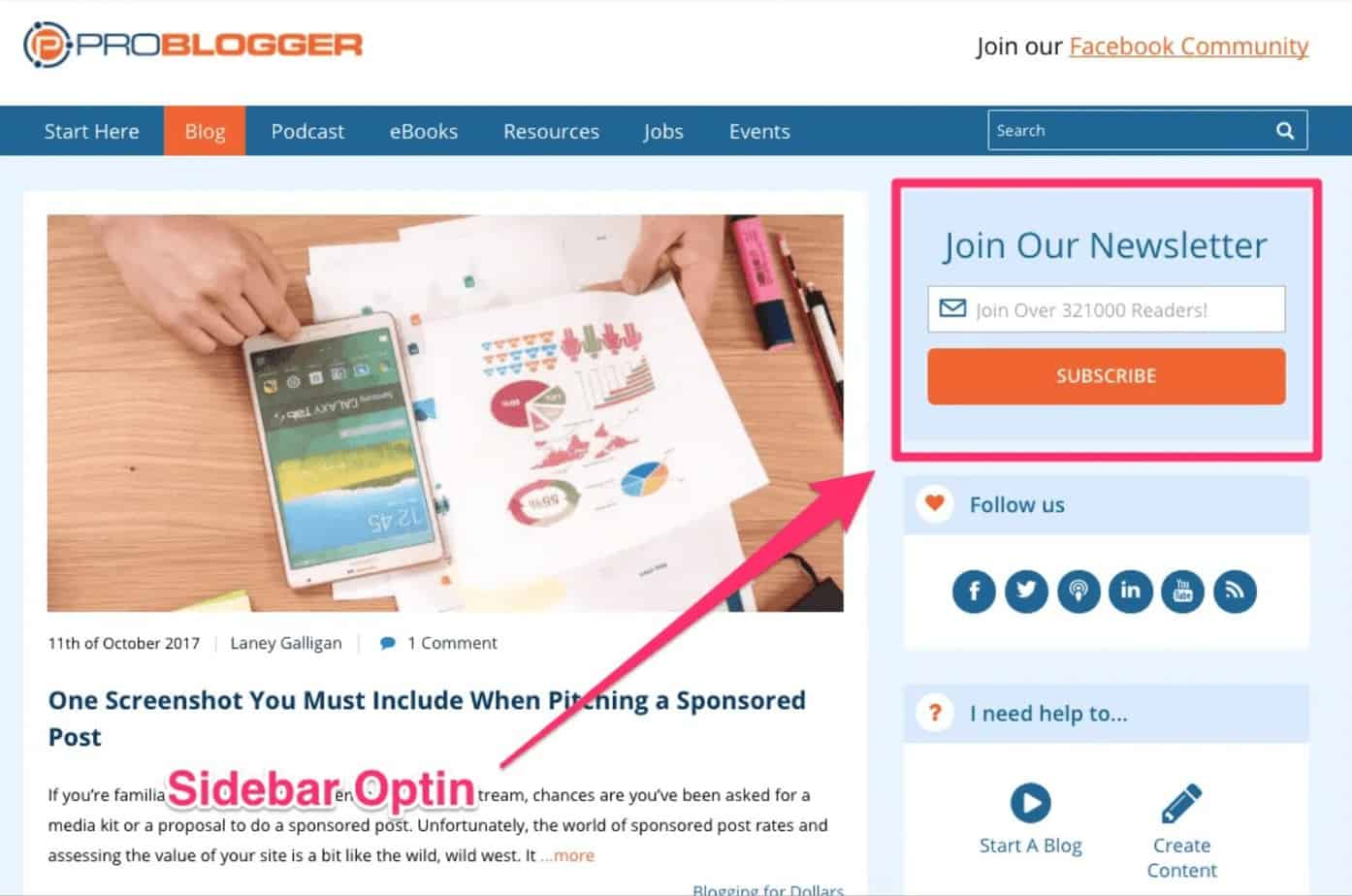
But don’t leave it at that – you need to place your optin form in at least three other places on your website.
Lightbox
A Lightbox is a popup form that is triggered to appear when your visitor:
- Has been on your page for a certain time (e.g. 10 secs)
- Is about to leave the page
- Has scrolled to a certain point on the page
Some people find them annoying because they interrupt what the visitor was doing.
But studies have shown over and over again that they work (precisely because they interrupt the visitor and demand attention).
CrazyEgg cites a study which found that a popup resulted in 1375% more new subscribers than a traditional sidebar optin box.
Here’s an example from SocialTriggers, the website of entrepreneur and web marketing expert Derek Halpern:
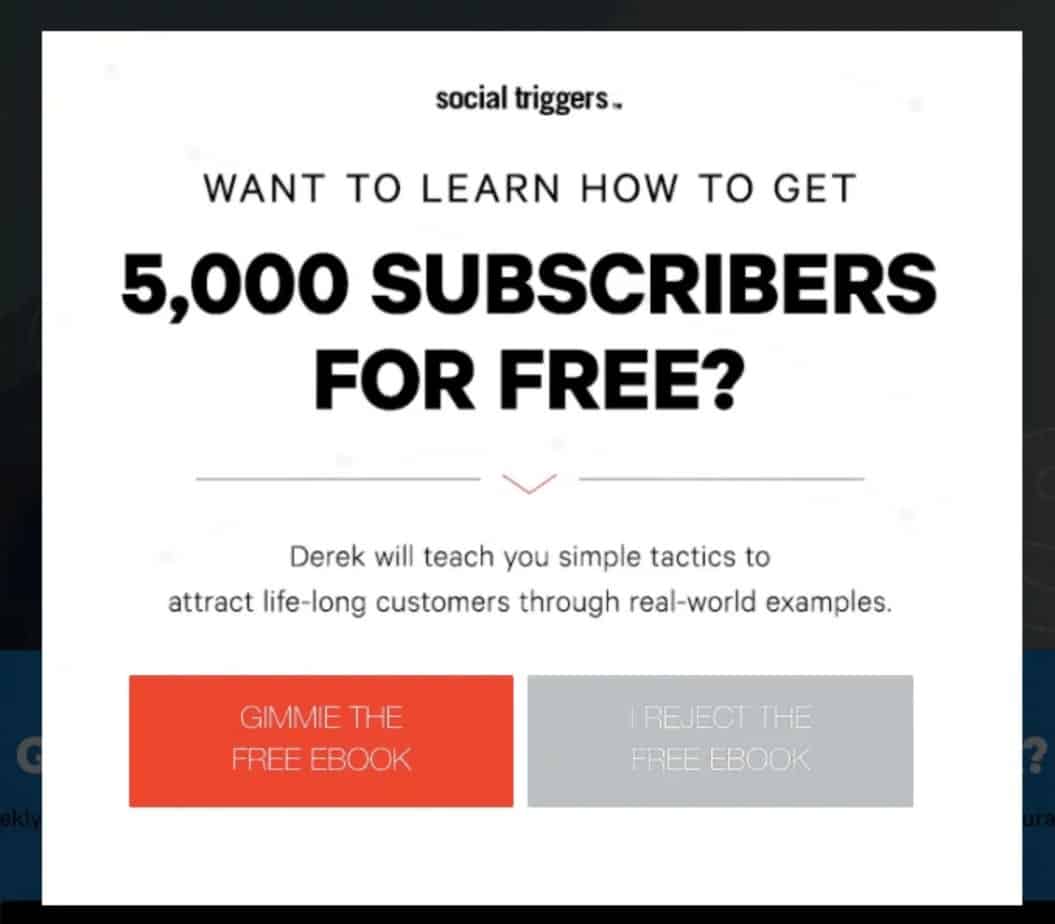
Feature Box
A Feature Box is a full width optin box that usually appears on every page of a website, just below the top navigation menu.
Jon Morrow makes good use of a feature box on SmartBlogger:
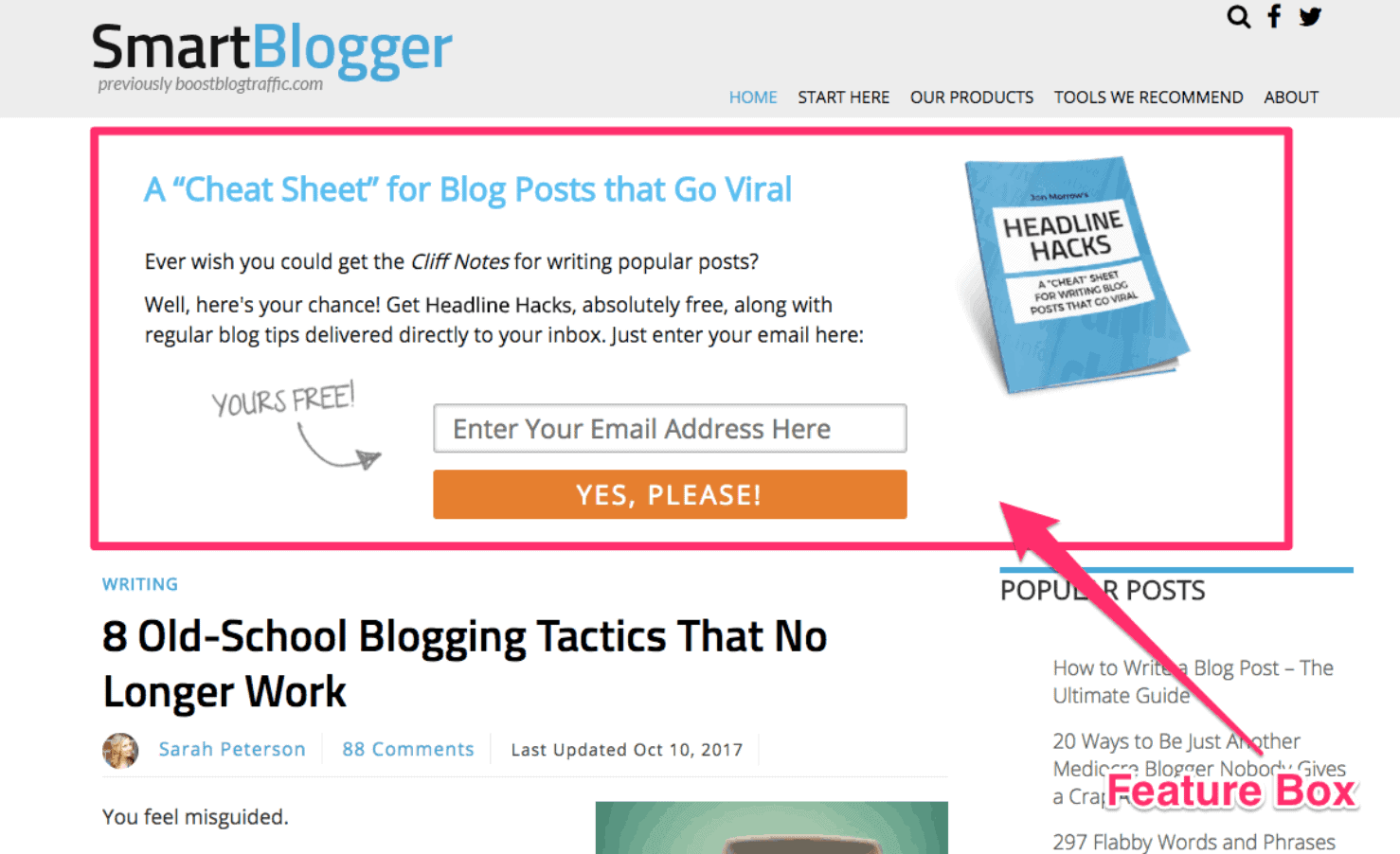
Slide-In
A Slide-In is a small optin box that slides in unobtrusively, usually from either the bottom left or bottom right of the screen.
They’re a good option if you’re worried that a popup will irritate and alienate your visitors.
Slide-Ins are usually triggered when the visitor scrolls down to a certain percentage of the webpage.
Content Upgrade
A Content Upgrade is a downloadable resource that is directly related to the topic of a particular blog post.
Often it will contain information or resources that are additional to what’s contained in the article (hence the word ‘upgrade’).
But sometimes, a content upgrade is simply the same information in another format (e.g. as a PDF or as an audio file).
Well-known web marketer Neil Patel makes good use of content upgrades:
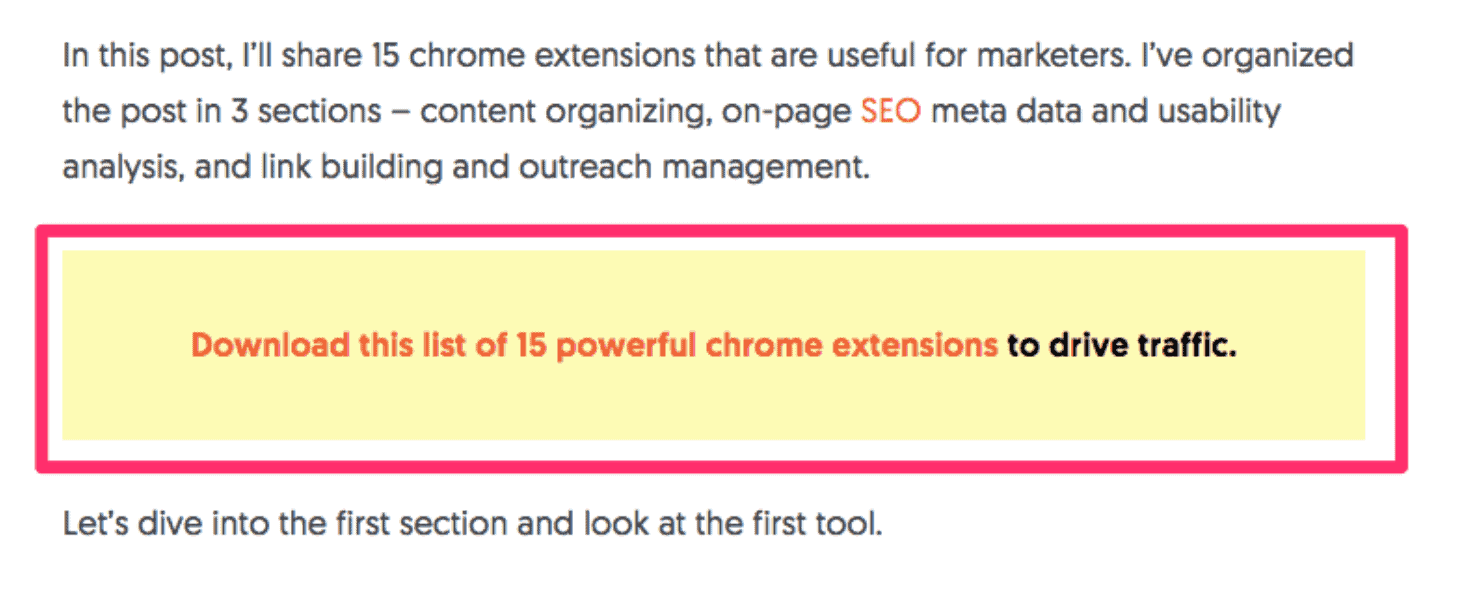
When you click on the above link, an optin box appears where you enter your name and email address:
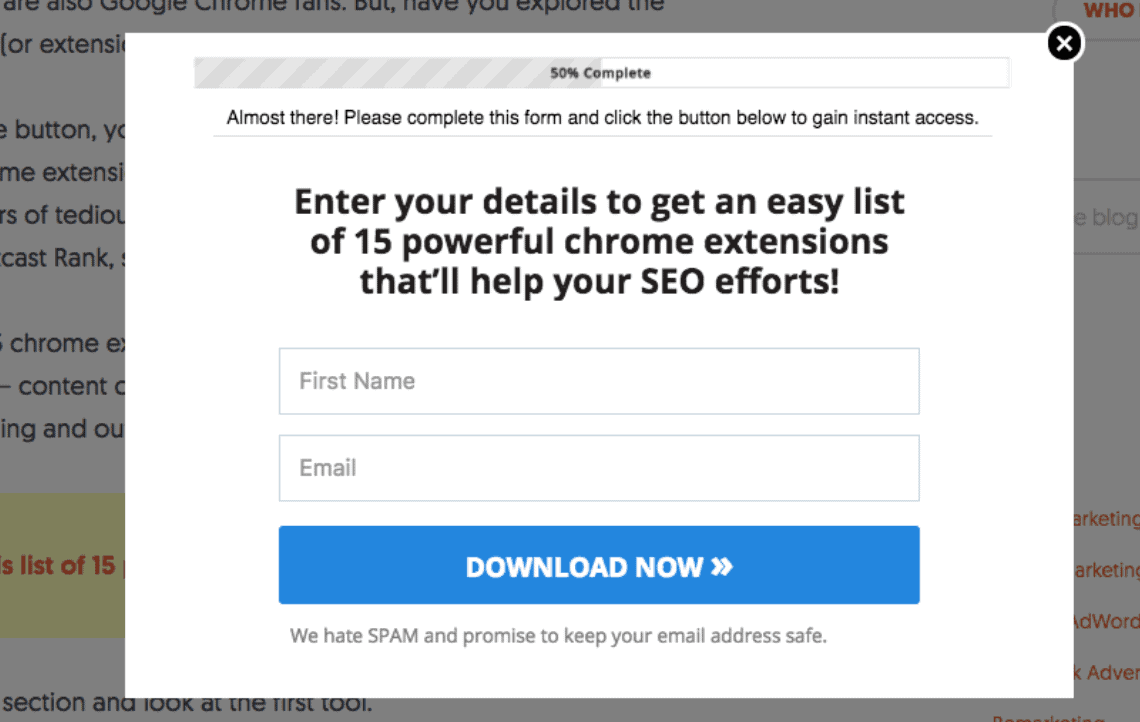
One of the reasons Content Upgrades work so well is that they take advantage of the psychology of ‘micro commitments’.
This is a law of human nature described by American Professor of Psychology Robert Cialdini in his book Influence: The Psychology of Persuasion.
The law of micro commitments says that we are much more likely to complete a task that is potentially challenging (e.g. making a purchase or signing up for a newsletter) if we first undertake a much smaller task that is not challenging.
A content upgrade is what’s known as a ‘Two Step Optin’ – first you click on the link and then an optin form appears where you enter your email address.
The act of clicking on the link is the smaller task, the micro commitment.
Once your visitor has done that, its much more likely they’ll follow through and complete the optin form.
Footer
A Footer Opt-in is an opt-in box that appears at the foot of every web page.
Ribbon or Bar
A Ribbon or Top Bar is a narrow strip that sits at the top of your web page. It contains a one-line message plus optin form.
You can see a top bar in action on Darren Rowse’s website, ProBlogger:
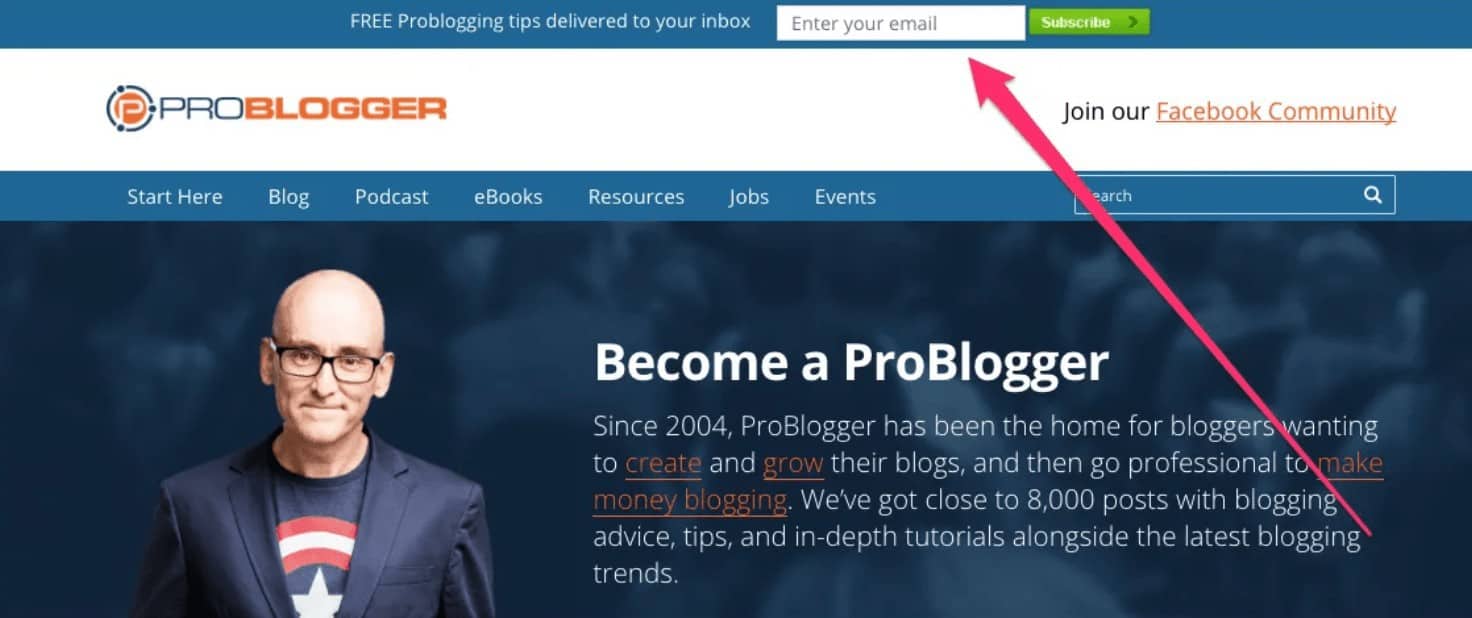
The most popular ribbon or bar optin is Neil Patel’s Hello Bar.
Scroll Mat (aka screen overlays, screen fillers)
A scroll mat is a high impact optin form. It appears as soon as someone lands on your website and it occupies the entire screen.
Here’s an example from the website of entrepreneur and virtual staffing expert Chris Ducker:
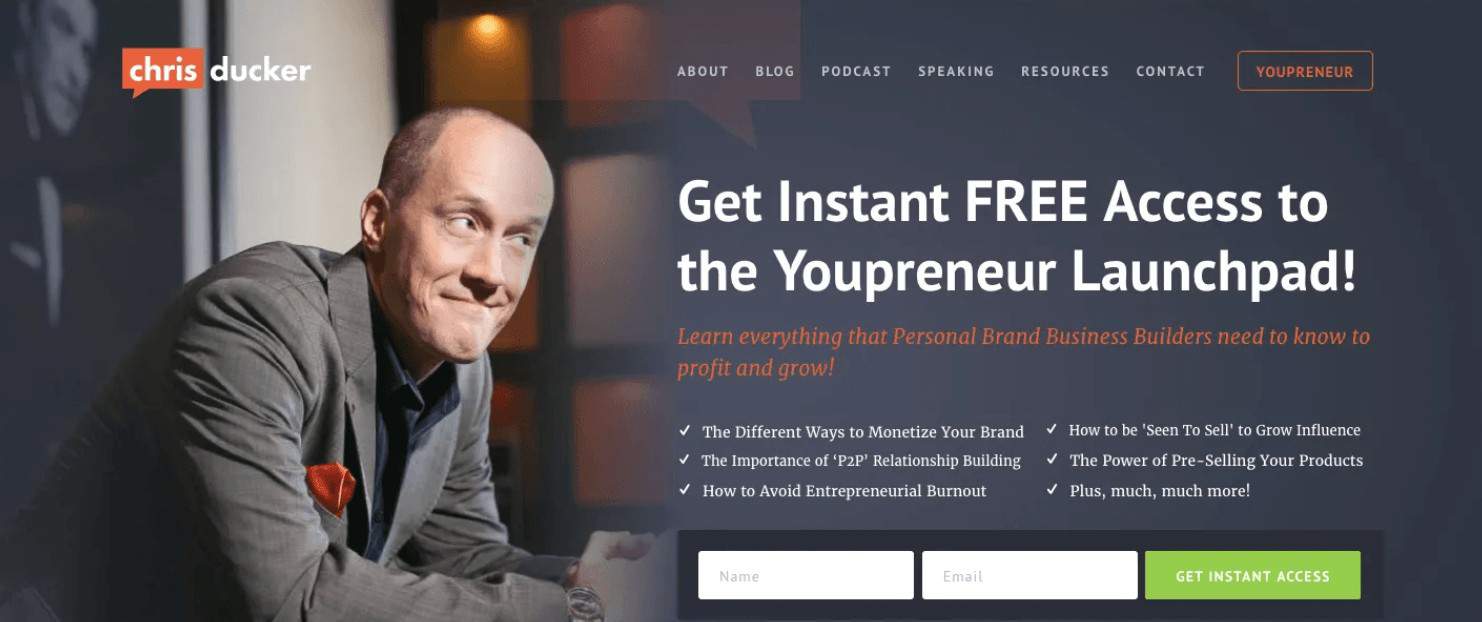
Single opt-in or double opt-in?
This is a vexed question amongst email marketers.
Single Optin is where the visitor enters their email address, receives a welcome email plus relevant lead magnet, and they’re on your list.
Double Optin is where the visitor enters their email address and then receives an email asking them to confirm their subscription. When they click on that link they then receive a welcome email plus download link for the relevant lead magnet.
There are good arguments for and against Double Optin:
Double opt-in: Pros
- Better engagement because the user took the extra step of confirming – they really want to be on your list
- Better protection for you in the event that a subscriber complains that they never subscribed
- No bots or fake email addresses on your list
- No incorrect or misspelt email addresses
- Some countries and jurisdictions may require double optin
Double opt-in: cons
- People now expect instant gratification – if you offer a lead magnet, they want it instantly (double optin means they first have to check their email and click on a link, then wait till they receive a second email with the download link).
- You’ll lose some subscribers who fail to take the second step of confirming their email address
It’s generally agreed that single optin is the fastest way of building a list.
As GetResponse notes: every time you add an extra step to any process, your conversion rate goes down.
According to GetResponse: “marketers generally see about 20-30% faster list growth when they use single opt-in”.
Personalization of emails
Should you collect an email address and a name or just an email address?
As with Single Optin vs. Double Optin, there are good arguments on both sides.
Here are the Pros and Cons of asking for a name:
Collecting names: pros
A 2014 study by Experian found that personalized emails generate 6 times higher transaction rates than non-personalized email.
Collecting names: cons
- People are not fooled because you have their name in the subject line – no one receiving a personalised email thinks that you know them by name.
- Your friends are not going to use your name when they email you – people who know you don’t begin emails with ‘Dear Tommy’ (and they definitely don’t use first names in the subject line!)
- Including a name field on your optin form reduces the optin rate by anywhere from 10% to 20%.
- A percentage of subscribers will enter fake names like ‘Anybody’, John Doe’, ‘Who Cares’. An email personalized with those details is worse than a non-personalized email: imagine getting an email with the subject line: ‘John Doe – 5 Ways To Increase Your Traffic in 2017’.
- According to a 2010 study by GetResponse, personalized emails get 26% more complaints and 71% more unsubscribes than non-personalized emails.
Using lead magnets
In the old days (pre-2005) people would sign up for a newsletter at the drop of a hat.
No longer.
To get an email address you now have to offer something in exchange. That thing is referred to as a ‘lead magnet’ or ‘optin bribe’ (ugly term).
Lead magnets take many forms. Here are some of them:
Checklists
Checklists are simply a list of items with a check box against each item.
Usually, it’s a list of tasks that need to be completed in order to achieve a certain goal.
- List of things to take on a fishing trip
- List of things to do to make your site load faster
- List of things to do to optimize a post or page for SEO
Checklists convert well as lead magnets because they provide condensed information, usually on a single page, that can be consumed quickly.
Cheat Sheets
Cheat Sheets are a list of tips or guidelines on a particular topic.
They work well as lead magnets because they condense a topic into one page and because the name implies a timesaving shortcut.
Templates
Templates are usually pro forma email messages that the user can adapt by changing a few words here and there. They might be templates for blogger outreach, guest post submissions, broken link building campaigns, and so on.
The appeal of templates is that people want to use a form of words that has already worked for someone else.
Swipe Files
A swipe file is similar to a group of templates – it’s usually a collection of advertising or sales letters that have been proven to get results.
Toolkits
Toolkits are simply a list of all the tools that you use to run your blog, from blogging platform to keyword research tool.
The appeal of toolkits is that people who are less advanced in blogging than you are know they can save themselves a lot of time and frustration by finding out what tools you use to run a successful blog.
Worksheets
A worksheet usually consists of several pages of exercises designed to accompany an online course.
Worksheets often allow a student to apply the principles they’ve learned in the course to their own particular situation.
PDF Versions
A PDF Version is the easiest lead magnet to create – it’s simply your blog post or article saved as a PDF.
The appeal of PDF Versions is that people can print out your article or blog post or simply read it in another format.
Quizzes
Quizzes are a new kind of lead magnet and very effective.
Wordstream reports that when quizzes are used for
One of the reasons quizzes work very well as lead magnets is that they interact with the user.
Depending on the answers the user enters, the quiz will often come up with a recommendation that is unique for the user (in exchange for an email address).
To get an idea of how a quiz works as a lead magnet try taking the quiz on Ramit Sethi’s home page:

But lead magnet quizzes can be used for much more than
You can also use them to gain valuable information about your subscriber’s interests.
That information can then be used to segment your list.
And as I discuss below, list segmentation increases open rates, click through rates and conversions.

(Source)
Getting Whitelisted
Even though your subscriber has opted to receive your emails, that doesn’t necessarily mean that your emails will reach them.
Why?
Because spam filters may send your emails straight into a junk mail folder.
The solution?
In your very first email to your new subscriber, ask them to add you to their whitelist:
To ensure delivery of emails to your Inbox, please add email@yourdomain.com to your address book or whitelist
You could also refer your new subscribers to a web page that contains whitelisting instructions for all the major email clients / service providers.
Emails: Plain Text or HTML?
There are certainly advantages to sending HTML emails as opposed to plain text. For one, your emails will be more visually engaging.
But there are also good reasons to send your emails as plain text rather than HTML:
- Greater deliverability – everyone can receive and send a plain text email
- With HTML it’s easier for something to go wrong – just one broken HTML tag and tour email will likely end up in the junk folder.
- People associate HTML emails with marketing (friends don’t send HTML emails)
If you’re still in doubt, here’s another reason to send your emails as plain text:
- Hubspot found that HTML emails had a 25% lower open rate than their plain-text emails.
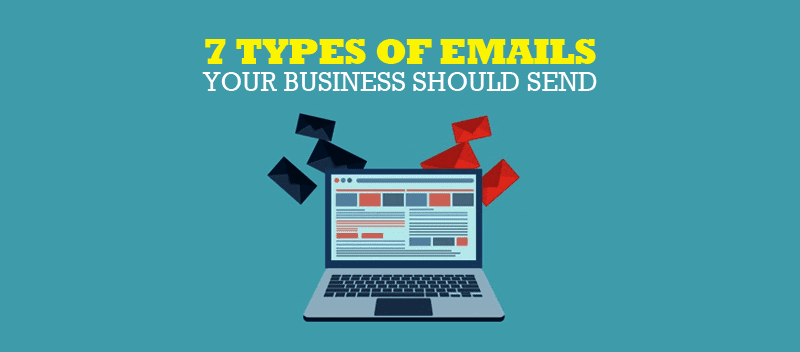
(Source)
Types of Emails To Send
This is another key aspect of understanding how email marketing works – deciding what sort of emails you’re going to send.
Newsletters
Newsletters were popular in the early days of the Internet (late 1990s to about 2005).
They were often quite intricately formatted (using plain text), with a Table of Contents, a main feature article, and various sections dealing with different topics.
Newsletters vs. email updates
But newsletters have largely been replaced by the email update, which is a much shorter email designed simply to get the user back on to your website.
For bloggers, an email update is an email of no more than 100 or 200 words informing the subscriber about a new blog post, with a link to the blog post.
Jon Morrow has written a very helpful article on this topic, titled Why You Shouldn’t Create a Newsletter (and What to Do Instead).
In a nutshell, Jon argues that newsletters are a one-way technology that belongs to the pre-blogging era, when websites were static and unidirectional in terms of communication.
He argues that if you’re publishing a newsletter, instead of an email update that directs your subscribers back to your website, you are:
- Missing out on thousands of new subscribers
- Strangling growth by word-of-mouth
- Depriving yourself of feedback from your readers telling you exactly what you’re doing right and wrong
An example of an email update
If you’re wondering what you should be sending instead of a newsletter, this is an example of an email update from Jon Morrow:
Enter your text here…
Enter your text here…
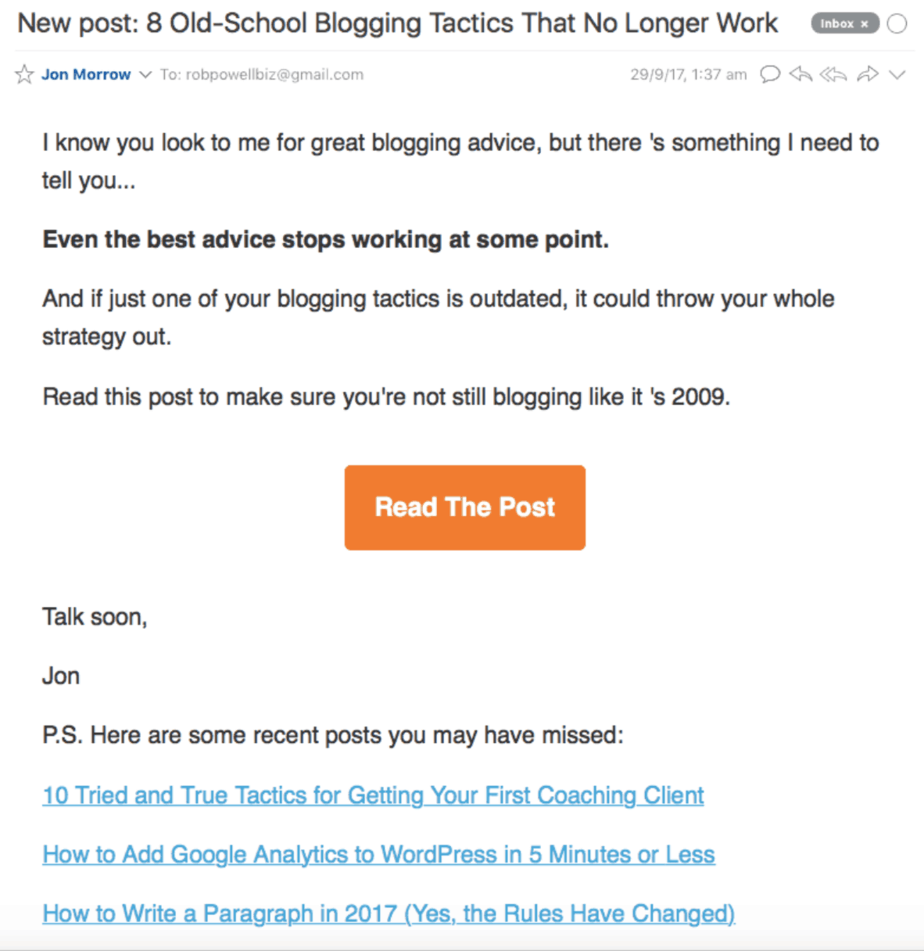
As you can see, it’s short and sweet and it’s main purpose is to get the reader back on to Jon’s website (https://smartblogger.com) where the reader can:
- Leave comments on SmartBlogger’s content
- Share SmartBlogger’s content on social media
This is the model I use as well (a brief email update rather than a newsletter) and I highly recommend it.
Notice also (in the context of our earlier discussion about personalization of emails) that Jon doesn’t try to personalize his email.
Lead nurturing emails
This kind of email is based on segmentation within your audience – different emails depending on where a subscriber is within your sales funnel.
Typically a lead nurturing email is an auto responder series. For example, a series of 5 emails explaining how to set up a blog on WordPress.
The main function of lead nurturing emails is to guide the user further down your sales funnel.
Informational emails
Informational emails could be about new content on your website, a product update, or news of an upcoming event.
Transactional emails
Transactional emails are automatic emails that are triggered when a user performs a particular action (e.g. a welcome email when someone joins your list).
For example, I have various content upgrades within specific blog posts.
When a user signs up to my list from a content upgrade, an email is automatically sent (using Amazon Simple Email Service) to the new subscriber with a link for downloading the content upgrade they requested.
For more information on how to set this up, read my article Lead Magnet Delivery – How To Do It Using Thrive Leads.
Timing & Frequency
There’s no hard and fast answer as to when and how often you should mail out to your list.
But here are some well-known facts about timing and frequency for email marketing:
- Nearly all successful email marketers stick to a schedule.
- Subscribers who know they can expect an email from you at a set and predictable interval will be more engaged with you.
- Unreliable and sporadic emailing results in a disengaged subscriber base
- If the intervals between your emails are too long, some subscribers may forget who you are and mark your email as spam.
Some people email 3 or 4 times a week, others twice a week, and others once a week.
Bloggers who use email marketing primarily to promote their blog posts usually email once a week, and that’s what I do.
But frequency is not as important as consistency. The important thing is to pick a schedule and then stick to it (even to the day of the week).
Here’s an excellent article on the subject of email frequency by Jeremy Reeves: Email Marketing – The Cold Hard Truth About Frequency.
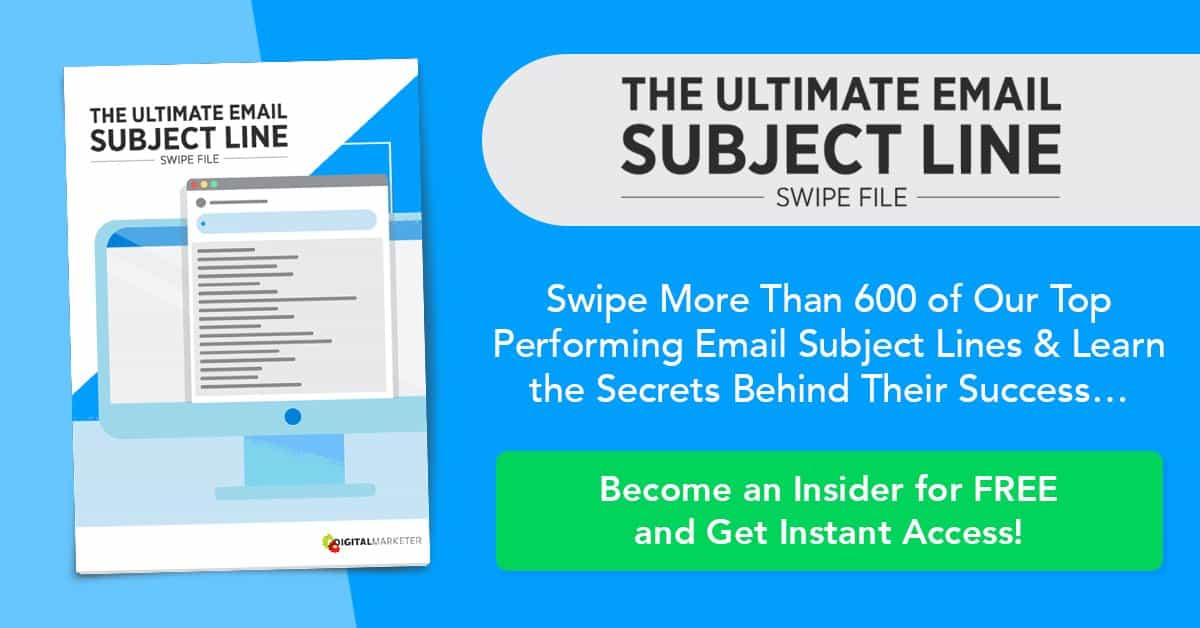
(Source)
Email Subject Lines
The subject line of your email is a hugely important aspect of email marketing.
Hubspot reports that 33% of email recipients open email based on subject line alone.
Digital Marketers analysed 107,442,263 emails and picked the best performing 101 subject lines.
From that sample they were able to identify the following 8 components of a successful email subject line:
- Self-Interest
- Curiosity
- Offer
- Urgency/Scarcity
- Humanity
- News
- Social Proof
- Story
For more about this study, see Digital Marketer’s 101 Best Email Subject Lines of 2016.
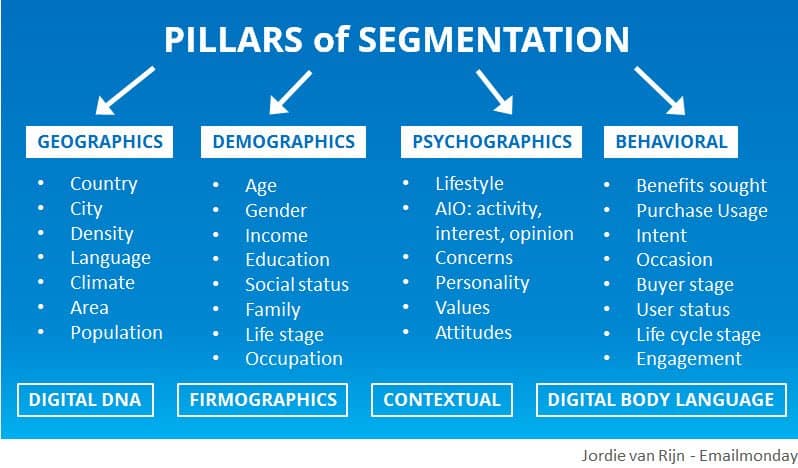
(Source)
List Segmentation
An unresponsive email list is very often the result of the owner blanketing their subscribers with the same message.
To put it another way: unsegmented lists are nearly always unresponsive lists.
An example of list segmentation
Imagine for a moment that you own a large pet shop in a large city and you’ve built up an email list of 10,000 loyal customers.
They’re all people who’ve been into your store at one time or another and have bought something in one of the following 10 categories:
- Tropical fish
- Marine Fish
- Budgerigars
- Kittens
- Puppies
- Reptiles
- Hamsters
- Rabbits
- Guinea Pigs
- Mice
Each week you send out an email about a special offer in one of these 10 categories.
The result?
For every email you send out 90% of your readers will be uninterested in your message.
On the other hand, imagine if you had segmented your subscriber list according to what category of pet they purchased.
And imagine that instead of sending out one generic email each week, you send out 10 different messages, one for each category of pet.
The likely result?
Instead of a 10% engagement rate, you’d have closer to 100% engagement.
That’s the power of segmentation.
Common types of list segmentation
Lists can be segmented in any number of ways but here are some common types of list segments:
- Demographics
- Email Engagement
- Geographic Area
- Past Purchases
- Amount Spent
- Position in the Sales Funnel
- Website Behaviour
One very useful way to segment a list is by audience interest.
If you run an Internet Marketing blog, for example, you could segment your list by these kinds of interests:
- Blogging strategy
- Copywriting
- Creating Blog Graphics
- Expert Roundups
- Getting Ideas for Blog Posts
- Google Analytics
- Guest Posting
- Influencer Outreach
- Keyword Research
- Lead Magnets
- Link Building
- List Building
- PPC Advertising
- Sales Funnels
- SEO
- Writing Blog Headlines
But how would you acquire this kind of information?
Using quizzes to segment your list
Quizzes area a great lead magnet – they can achieve opt-in rates as high as 50%.
A cleverly designed quiz can be used both as a lead magnet and as a way of finding out about your new subscriber’s most pressing interests, problems, or concerns.
Quiz technology has advanced in leaps and bounds over the last 12 months.
Here are three of the leading online quiz solutions. They’re mainly focused on
In a nutshell, segmentation increases open rates, click through rates and conversions.
Marketing Sherpa reports that segmenting your emails can increase revenue by 50%.
Yet 42% of marketers do not send email messages that target subscribers by segment.
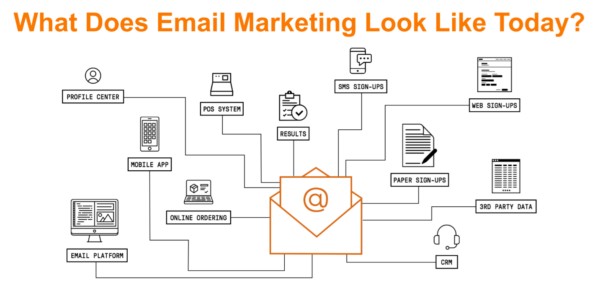
(Source)
Email Automation
Email automation is another key aspect of how email marketing works.
With email automation you can set up pre-written emails that will be triggered when your website visitors perform certain actions.
To do this, you need to look at how your website addresses the needs of people at different stages in your sales funnel.
Your automated emails will effectively move people through your sales funnel.
Hubspot’s article 13 Email Workflows You Should Be Using in Your Marketing Automationexplains this in more detail.
Email Funnels
An email funnel is any arrangement of web pages, opt-in forms, lead magnets, welcome messages, and auto-responder sequences that guides and funnels incoming traffic towards a goal.
For more on this topic, see Campaign Monitor’s article: How to Build an Email Marketing Funnel For Conversions
Email Marketing Metrics To Measure
To succeed with email marketing, you need to measure results.
If you don’t measure, you won’t know if your email marketing efforts are helping you reach your goals.
Here are 5 key email marketing metrics that are worth tracking:
Click-through-rate (CTR)
Click Through Rate is the percentage of email recipients who clicked on one or more links contained in a given email.
CTR is calculated as Unique Clicks divided by Number of Delivered Emails x 100
Conversion rate
Conversion Rate is the percentage of email recipients who clicked on a link within an email and completed a desired action.
CR is calculated as Number of Recipients Who Took the Desired Action divided by Number of Delivered Emails x 100
Bounce rate
Bounce Rate is the percentage of total emails sent that could not be delivered to the recipient’s inbox.
Bounce Rate is calculated as Number of Emails Returned as Undeliverable divided by Number of Emails Sent x 100
List growth rate
List Growth Rate is the rate at which your email list is growing.
LGR is calculated as (number of new subscribes) minus (number of unsubscribes) divided by number of emails sent x 100
Overall ROI
Overall ROI is total revenue divided by total spend.
ROI is calculated as ($ in additional sales made minus $ invested in the camapign) divided by ($ invested in the campaign) x 100
Most of these metrics will be included in the analytics provided by your
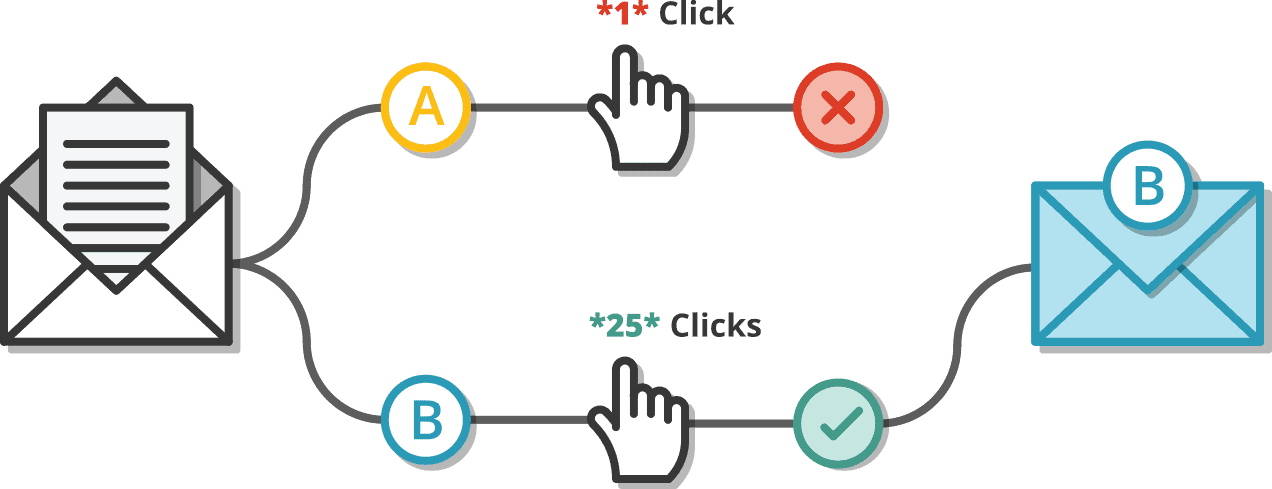
(Source)
Email A/B testing
There are so many variables involved in an email campaign and although you may have a hunch that something will work, until you try it you don’t know.
That’s why A/B testing is another key element in how email marketing works.
In A/B testing you run two alternative messages against each other, and then pick the winner.
You then do it again, pitting a new message against the previous winner.
That way you’re able to constantly sharpen and improve your marketing.
Here are some of the variables that you can A/B test:
- Call to action
- Subject line
- Testimonials (include or not)
- Layout of the message (single column vs. two column)
- Personalization (with and without)
- Body text
- Headline
- Closing text
- Images
- The specific offer (Example: “Save 10%” vs. “Free Gift”)
For more information read Kissmetrics A Beginner’s Guide to A/B Testing: Email Campaigns That Convert.
Conclusion
Whether you have a product to sell or just use email to promote your blog posts, email marketing is a powerful business tool.
It is still the highest converting marketing channel with the highest ROI.
It’s also the only marketing channel in your toolbox that is entirely yours.
But to use it effectively you need to understand these key elements of how email marketing works:
- Optin Process
- Optin Forms
- Lead Magnets
- Getting Whitelisted
- Types of Emails To Send
- Timing & Frequency
- Email Subject Lines
- Segmentation
- Email Automation
- Email Funnels
- Measuring Metrics
- Email A/B testing
If you’re having trouble building your list or if you have a list that’s not producing results, I hope this article will help you turn that around!
More Articles About Email Marketing
- 10 Best Email Marketing Services & How To Choose
- How To Use ConvertKit – 11 Useful Features You Need To Know
- 21 Headline Analyzers For Better Click-Through Rate (CTR)
- How To Build Your List on Medium & Grow Your List Fast
- How To Deliver Content Upgrades For Free In 7 Easy Steps
- 10 Best Lead Capture Tools For List Building in 2022
- Best Lead Magnet Delivery Techniques in 2022
- 39 Awesome Exit-Intent Popup Tips To Grow Your List Faster
Thanks for an in-depth article! It’s a good start for anyone beginning their journey with email, but I was also wondering how different would it be with marketing automation? Is it more complicated? I’ve seen some email tools, like GetResponse, offer now marketing automation and I was wondering why.
Hi Bran, thanks for your comment!To answer your question, marketing automation would help with aspects such as segmentation, measuring metrics, A/B testing, and even some aspects of creating email funnels. But other aspects, such as designing and creating lead magnets, deciding where to place optin forms, and crafting compelling subject lines would still be ‘hands on’ aspects of email marketing. Hope this helps.
Hi Rob,
Fantastic post as always 🙂
I love reading your posts because I have come to associate 2 things with you: detailed research, and great writing.
Interesting thought on personalization of emails. I am of the view (as a list grow strategist) that I need to know the first names of those joining my tribe. Even if they are not honest initially, I believe that as the relationship evolves, they will update their details.
And its interesting that I received an email from Ana Hoffman (Traffic Generation Cafe) on this very subject only yesterday.
Here’s what Ana said:
“HELP ME REMEDY A FOOLISH NEWBIE MISTAKE
Back when I was a relative newbie to the marketing industry, I listened to some bad advice – NOT to ask folks who wanted to join my subscribers’ list for their first name.
Logic behind it: the least info you ask for, the more people you get on your list.
SERIOUSLY?!!!
What can I tell ya, it takes time and growth to know what I know now:
Quality is the best business plan.
I’d rather have a handful (figuratively speaking) of people who WANT to be on my list, whom I know by name, business, the number of kids they have, and the challenges they face, over “122,000+ other smart marketers loving my emails”…
NO QUESTION ABOUT IT.
So, I may or may not have your first name in my ‘digital address book’, and I’d love to make sure I do (and it’s the right one!)
Let’s fix that.
Hi, I am Ana. And you are…
=> Click here to update your info <="
Your thoughts?
Best regards,
Pedro
Hi Pedro, great to see you here again! And you just made my day 🙂 Thanks so much!
Yes, I saw that post by Ana the day after I published this article and it really made me rethink my position on personalization of emails. I have to agree that it does help to know their first names, it’s part of relating to a real person. And the more real the relationship with your subscribers, the better. I guess what Ana is saying is the 20% drop-off in conversion rate is more than made up for by a more personal relationship with your subscribers. I’m still not sure where I stand on this… Best, Rob.
This is a perfect guide for any beginner to the world of email marketing. It can often be super confusing when you are new to email marketing, and you may not be aware of how to go about things. This article is excellent as it talks about the various factors that can make email marketing campaigns a real success. I agree with every single point that has been mentioned above. I especially agree with personalizing emails as this can grab the attention of any reader. Thanks for this post!
Hi Debbi,
Thanks for your comment. Email marketing has a lot of moving parts and its hard to get them all working together. But when you do, it can turn a website into a thriving business.
All the best,
Rob.
thanks a lot for sharing such a detailed information about the email marketing.. you did a great job.
Thanks, glad you found it helpful, Rob.
I would like to say thank you for what you have done. I’m a beginner in marketing world. Thanks a lot!
Thanks for your feedback – you’re most welcome, glad it was helpful! Best, Rob.
Thanks, Jerry, I agree with you: A/B testing is the key. That way you can constantly improve through minor modifications. Regards, Rob